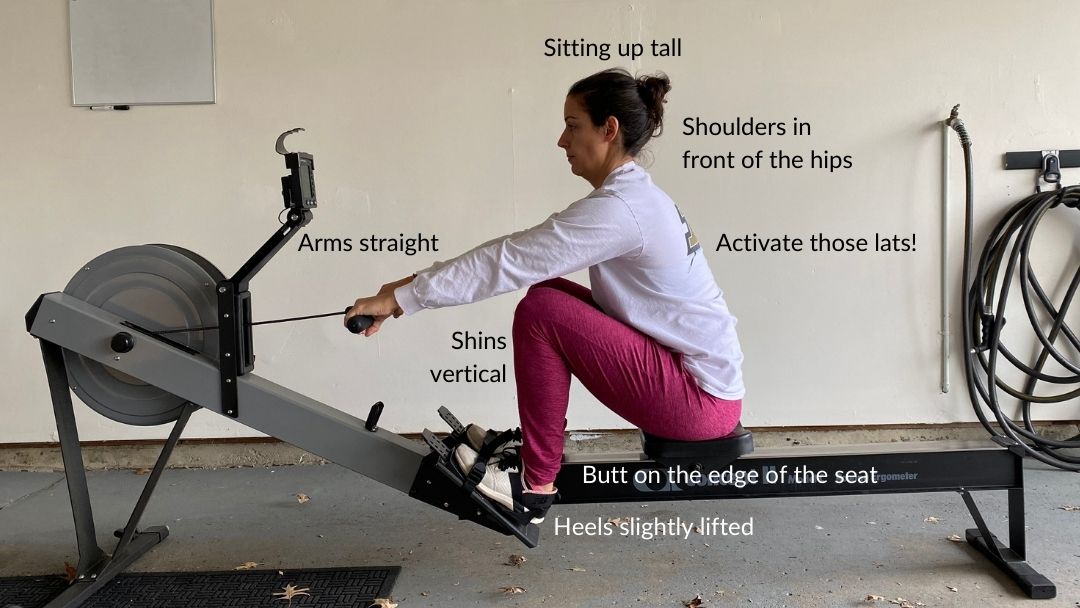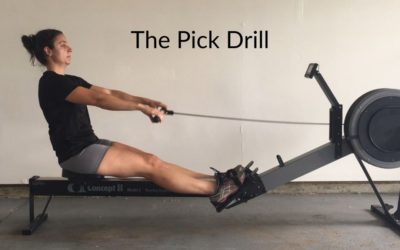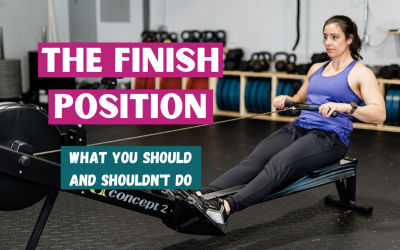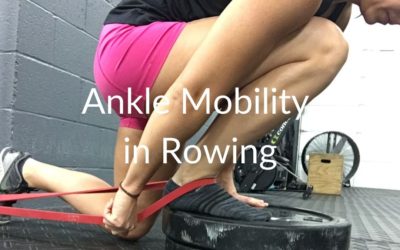Everything to Know About the Catch Position
There’s a lot that goes into having a good catch position on the rowing machine.
A good catch allows you to start your stroke off right and sets you up for success each and every stroke you take.
Here is a picture of a good catch position:

Here are the big things you want to look for in your catch position:
1) Butt on the edge of the seat
Sitting on the seat correctly sets you up well for a lot of the following points. We want our sit bones to be going directly down into the seat.
One way to make sure that you’re sitting correctly on the seat is to pick up your butt cheeks! Yep I said it! Pick those babies up so you can lean forward.
2) Shoulders in front of your hips
Getting your shoulders in front of your hips sets you up for a better drive. After you drive your legs down (on the drive) you’ll be able to swing your body open for more power. The body swing accounts for 30% of the stroke power, and if you aren’t getting your shoulders in front of your hips, you’re missing out on all that!
3) Sitting up tall
We don’t want to reach for extra length here and have our chest touch our knees. When we reach too far, we lose that tension in our shoulders, and when we go to take another stroke, we have to pull our shoulders back to be able to fully engage. Long story short, reaching at the catch will waste time and make you lose power at the catch. The extra length isn’t worth it!
4) Shins vertical
Stopping when your shins are vertical (or perpendicular to the ground) is the perfect balance between applying your power quickly and lengthening your stroke.
If you are overcompressing, so your shins are past vertical, it takes much longer for your heels to come back into contact with the footboards on the drive. We want to push through our heels on the drive, and when our heels come up too high, it’s easy to push through the balls of your feet instead.
Not everyone has the flexibility to make it all the way up to their shins being vertical. If it’s a mobility or pain issue, then come up as close to vertical as you can. Let the rower meet you where you are.
Stopping short of vertical cuts your stroke a little too short. It’s OK for your heels to lift slightly at the catch in order to get those shins vertical.
5) Heels slightly lifted
This will vary for everyone, but most people have their heels lifted slightly at the catch when they get their shins vertical. If you have the flexibility to keep your heels down with your shins vertical, that’s awesome!
6) Arms straight
We want our arms to act like straps at the catch. If you follow Whiteboard Daily on IG, you may have heard “when the arms bend, the power ends” in regards to weightlifting. The same is true in rowing!
We want to hang off the handle when we drive through our legs. THe best way for us to transfer that power is with straight arms! Bending those arms wastes precious energy that doesn’t go into getting you a faster split!
7) Activate those lats!
Before we start our drive, when we are at that catch position, we want to activate those lats and pull our shoulders back and down. Thinking about sitting up tall will help you get into this position.
This creates tension in our upper body that allows us to hang off the handle. When looking at the upper back and shoulders, it creates this scapular J.
It’s the same kind of tension in our upper body that we create before we deadlift, clean, and snatch with a barbell. In order to lift properly, we need those lats engaged before (and not during) the lift.
Working on your catch position will help you with the rest of your stroke. After all, starting the stroke right is the first step!
The Pick Drill
New to rowing? Need a technique overhaul? I highly suggest starting with the pick drill. The pick drill is useful in a lot of different ways. For beginners, it’s a great way to learn the stroke. You’re not worried about power, just correct movement. For more advanced...
Do’s and Don’ts of the Rowing Finish Position
Today, I'm going to be talking about the finish position. That's going to be the back part of your stroke, where you finish your drive. I'm going to talk about what you want to be doing, and what you want to be on the lookout for when critiquing your own rowing...
Ankle Mobility in Rowing
Most people may think you don’t need much mobility in order to row. They may be correct, but you do need plenty of mobility to row WELL. One area that I want to focus on is ankle mobility. I want to explain why this is important, and some exercises you can do before...



